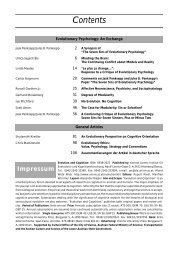Contents - Konrad Lorenz Institute
Contents - Konrad Lorenz Institute
Contents - Konrad Lorenz Institute
You also want an ePaper? Increase the reach of your titles
YUMPU automatically turns print PDFs into web optimized ePapers that Google loves.
Of Brains and Minds<br />
does not detract from the fact that all organisms,<br />
whether they are simple reflex automata or active<br />
and complex explorers, are above all concerned<br />
with keeping track of their local spatio-temporal environment,<br />
as part of their struggle for existence.<br />
Since sensory information processing and the ability<br />
to model reality (or certain parts of it) are essential<br />
components in this process, our idea of problem<br />
solving seems to correspond reasonably well to the<br />
notion of intelligence.<br />
However, the common use of the term ‘intelligence’<br />
applies not only to processes involving complex<br />
information processing (perception) but includes<br />
operations of the ‘mind’ as well (see, e.g.,<br />
DENNETT 1983; MACPHAIL 1985, 1993). It means that<br />
if to a group of organisms no thoughts, intentions,<br />
expectations and the like can reasonably be attributed,<br />
they are considered to be creatures lacking in<br />
intelligence. In order to avoid such subjective criteria,<br />
intelligence in the present essay is defined as the<br />
problem solving capacity of a species. It implies that<br />
intelligence is not a quality restricted to the functional<br />
domain of complex neural structures, but can<br />
in principle be attributed to all organisms, from<br />
amoeba to man.<br />
Although each organism is equipped with an execution<br />
potential which enables it to cope with a variety<br />
of problems in a specified environment, there<br />
are, of course, tremendous differences in the problem<br />
solving capacity among living beings, and thus<br />
in biological intelligence. Most of these differences<br />
are connected with the functional characteristics of<br />
the organism’s perceiving and executing apparatus.<br />
A coelenterate, for instance, with its diffuse nerve fiber<br />
network, has an action pattern which is of quite<br />
a different order of magnitude as compared to the<br />
rich behavioral repertoire of primates, with their<br />
highly evolved central nervous system. Therefore, it<br />
is only meaningful to compare the intellectual capacities<br />
of species when they have certain basic features<br />
in common.<br />
The mammalian brain can be considered to be<br />
such a structure, in that it is a multimodal integration<br />
system composed of a highly efficient hybrid<br />
device consisting of analogue neural units to process<br />
information and a digital wiring system for information<br />
transmission. In these highly organized<br />
animals information from the external world passes<br />
through three distinct stages or systems: a sensory<br />
transducer system, a perceptual input system (or<br />
systems) and finally a central cognitive system. During<br />
this ‘journey’ the otherwise overwhelming<br />
amount of sensory information is selected, analyzed,<br />
integrated and stored in accord with the species’<br />
attention and its needs and interests. It means<br />
that the picture that an animal has of its external<br />
world depends on (i) the quality of its sense organs,<br />
(ii) its information processing capacity and (iii) its<br />
informational and emotional states of mind. Consequently,<br />
‘world pictures’ of animals must perforce<br />
differ from each other, and can be looked upon as<br />
highly individual representations of the external<br />
world. Hence, it is appropriate to speak of speciesspecific<br />
perceptual worlds (JERISON 1973, 1991) or<br />
models of reality (WUKETITS 1986, 1990; RIEDL 1987;<br />
PLOTKIN 1994).<br />
Neural Worlds and Real Worlds<br />
The idea of a species-specific model of reality corresponds,<br />
to a certain extent, with KANT’s assumption<br />
that the world as we know it is our interpretation of<br />
the observable facts in the light of theories that we<br />
ourselves invent (POPPER 1958; see also VOLLMER<br />
1992). It means that models of reality, at least those<br />
of higher vertebrates, are related to both the external<br />
and the internal worlds and that it assumes the<br />
existence of some knowledge in the form of dispositions<br />
and expectations (POPPER 1972). The more<br />
complete and reliable these knowledge-based specific<br />
models are, the better the chance of survival. It<br />
enables the animal to make better predictions, especially<br />
predictions relating to features or situations<br />
which do not occur in stereotyped patterns.<br />
Though states of the brain represent states of the<br />
external world we do not perceive reality precisely<br />
as it is. The epistemological question now is how to<br />
address the relationship between the neural world<br />
and the real world. Perhaps representational models<br />
in the brain are roughly like a map in the sense<br />
that internal, abstract relationships map onto the<br />
external relationships between various categories in<br />
the world. According to this theory, put forward by<br />
CHURCHLAND and CHURCHLAND (2002), brains develop<br />
high-dimensional maps, the internal distance<br />
relationships of which correspond to the similarity<br />
relationships that constitute the categorial structure<br />
of the world. The rough and low-dimensional<br />
analogy is the road map of a city, in which the real<br />
spatial relationships between roads are represented<br />
in the relationships between road-lines on the paper<br />
map. Just as road maps come in varying degrees<br />
of reliablity and detail, so brain models of the external<br />
world map the categorial and causal structure of<br />
the world with varying degrees of reliablity and detail.<br />
A frog’s brain maps less of the categorial struc-<br />
Evolution and Cognition ❘ 179 ❘ 2003, Vol. 9, No. 2








